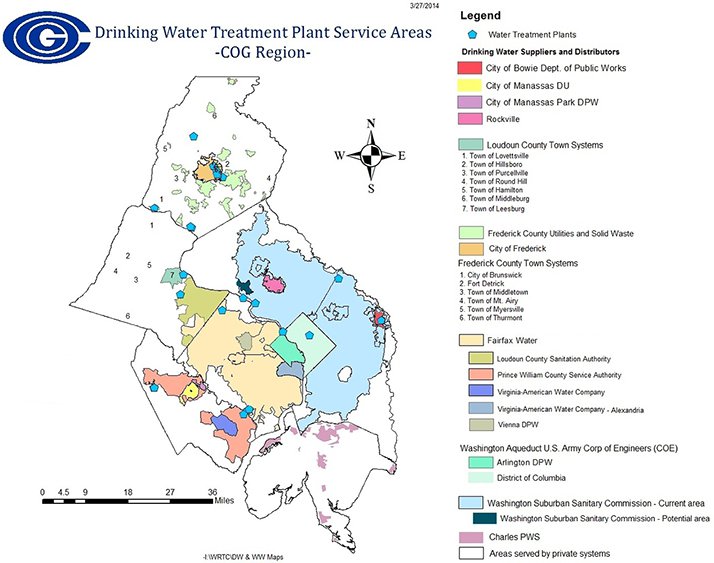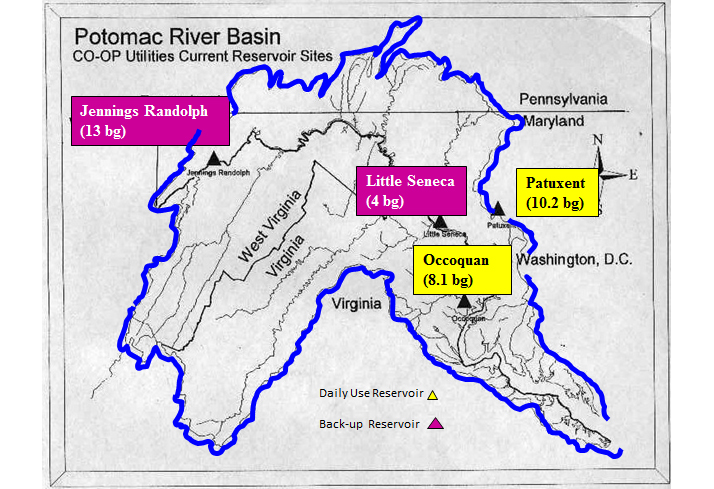Water specifically metropolitan Washington’s drinking water system was the focus of the Council of Governments’ first in-depth discussion on regional infrastructure in 2014. As Fairfax County Board of Supervisors Vice Chair Penny Gross noted while people see infrastructure all around them the vital water system is “buried and hidden from view.”
Except of course when serious issues arise and draw attention to challenges such as aging pipes long-term water supply needs and water quality and security. During the discussion at COG elected officials and water utility executives reviewed how drinking water is supplied to our region recent events like January’s chemical spill in West Virginia and last year’s outage threat in Prince George’s County and talked about ways to prevent and respond to similar situations.
(For news stories on the discussion from News Channel 8 WAMU scroll down.)
Bradford Seamon Prince George’s County Chief Administrative Officer recounted when officials called for mandatory water restrictions last July to allow the Washington Suburban Sanitary Commission (WSSC) to repair a broken water main. The restrictions would have affected over 100000 people during five hot summer days.
Fortunately WSSC found a solution and avoided the shutdown. Seamon said the event underscored the importance of coordination and communication among area governments and utilities. Alexandria Mayor Bill Euille recommended that local cities and counties explore arrangements like the region’s public safety mutual aid agreements to support each other during water emergencies.
Water Delivery
In addition to emergency coordination the Prince George’s event also sparked discussion about the region’s aging water systems. D.C. Water General Manager George Hawkins noted that every local water utility is dealing with distinct but significant capital repair and replacement needs. In the District for example Hawkins said there are 800 miles of cast iron pipes with an average age of 96 years. For decades he said customers were used to paying for operating costs not capital costs so recent efforts to replace and upgrade the system are causing “sticker shock” when people receive their water bills.
In addition to not being aware of the age and condition of many of our water pipes area residents may not realize the complex network that distributes drinking water across the region. In a presentation to the Board of Directors COG Senior Director Stuart Freudberg pointed out that the region’s 14500 miles of water mains are nearly as long as the number of highway lane miles and he shared a map (pictured below) illustrating the complex mix of drinking water providers. Another map (also pictured) highlighted where the region gets its water—over three-quarters from the Potomac River which provides for over 4.5 million area residents. The map also pinpointed reservoirs used on a regular basis (Occoquan and Patuxent) and for backup purposes (Little Seneca and Jennings Randolph) such as during droughts.


Long-Term Water Supply
In speaking of the Potomac as our primary water supply Washington Aqueduct General Manager Tom Jacobus said the region’s existing reservoirs should be sufficient through 2035 but he encouraged leaders to plan for the future. He noted that while the Jennings Randolph reservoir is an important reserve supply it can take nine days for the water to reach the region after it has been released.
Jacobus said officials are currently considering a quarry in Rockville as a possible reservoir site and Gross noted that Fairfax County is looking at developing an additional reservoir.
Water Quality and Security
For decades water quality and security have been major priorities for leaders at the Council of Governments and the events in West Virginia were a reminder of their continued importance. As mentioned in an earlier blog COG has worked with utilities and governments over the past three decades to develop and update water emergency plans. Our drinking water’s safety and quality is also continuously monitored by local utilities.
Officials at the COG Board meeting stressed that past plans and investments especially in regard to wastewater treatment have led to significant improvements in the region’s water quality – and quality of life. They also noted that further improvements to the quality of the Potomac Chesapeake Bay and other waterways will be very expensive.
College Park Mayor Andrew Fellows asked about the strategy of land conservation upstream in the Potomac to protect the watershed. Hawkins said New York owns land in the Catskills to protect the metropolitan area’s water. He noted that it can be cheaper to keep contaminants out of the water in the first place rather than cleaning them up after the fact.
Financing Improvements and Next Steps
Throughout the discussion officials like COG Board Chairman and D.C. Council Chairman Phil Mendelson brought up the question of costs to make the necessary investments in our water infrastructure. Rockville Mayor Bridget Donnell Newton asked about more equitable financing strategies that could help current ratepayers feeling the pain of increasing bills due to deferred past maintenance. Hawkins mentioned the possibility for longer-term bonds since some new infrastructure will last for generations.
Freudberg wrapped up the discussion by noting that after more infrastructure topics have been covered in the series COG will focus on the issue of financing these major projects.
About the 2014 Regional Infrastructure Series: COG has planned a series on regional infrastructure focused on its main areas of expertise such as transportation water energy and public safety communications. Officials hope the series will identify policy advocacy and outreach actions around key infrastructure needs. COG’s officials believe that long-term commitment to capital investment and maintenance of our infrastructure is vital to achieving our Region Forward vision for a more prosperous accessible livable and sustainable metropolitan Washington.
Media Clips from April 2014 discussion:
WAMU: D.C. Area Leaders Glean Lessons From Elk River Chemical Spill
News Channel 8: Experts warn chemical spills aging infrastructure could cut off D.C. water